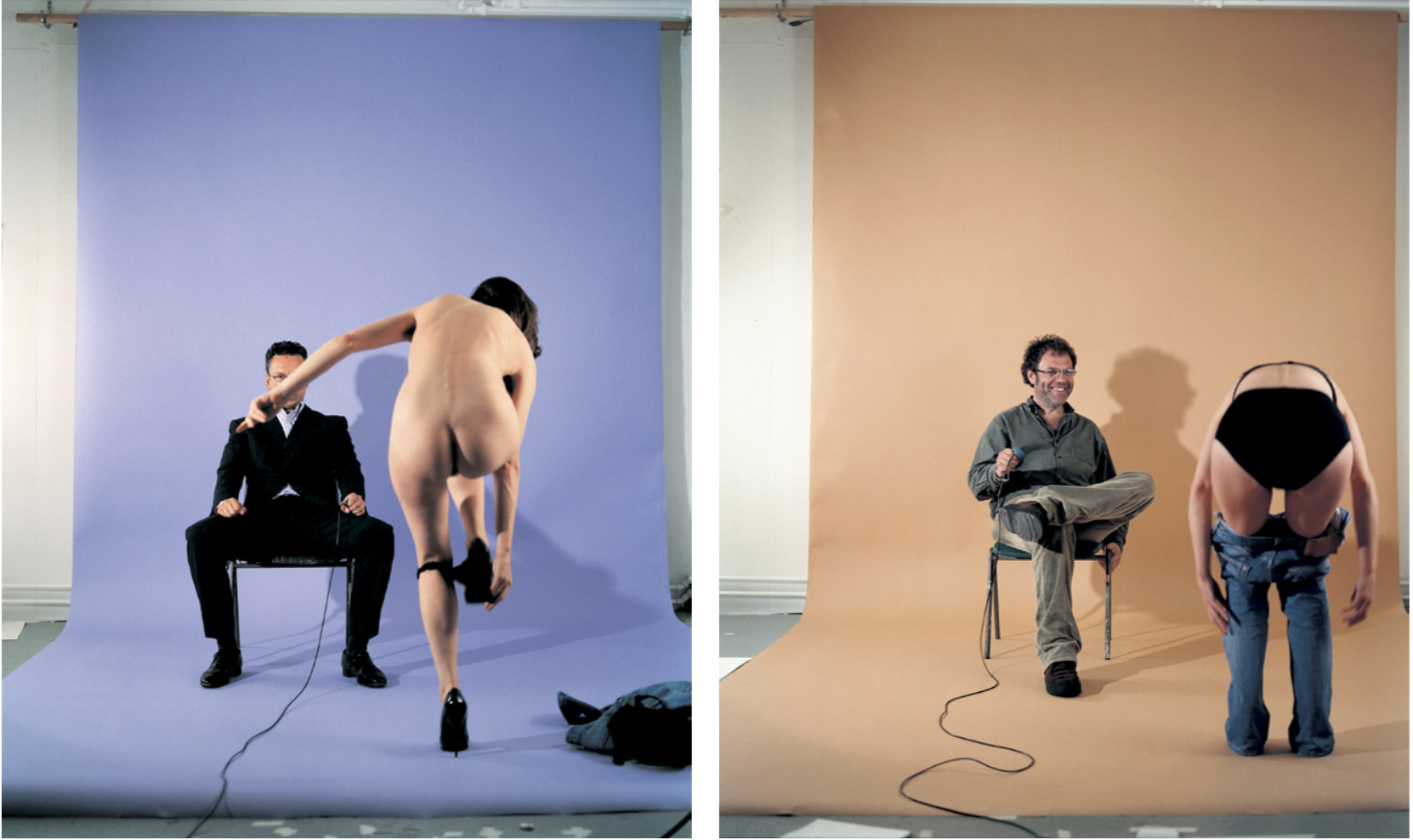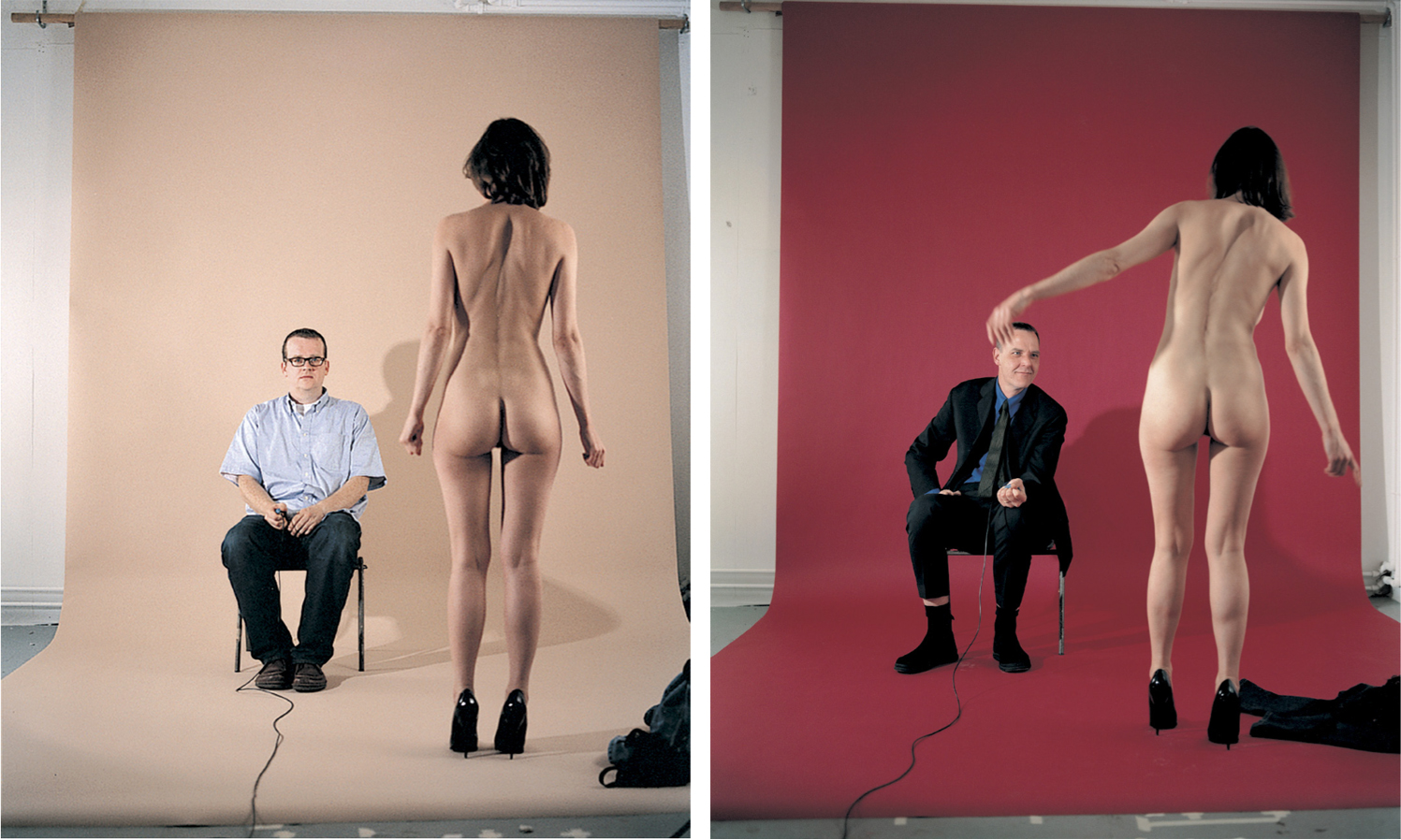Image above: Portrait by Jemima Stehli. All images courtesy of the artist from the Strip series.
Cory Rice: Your work is steeped in rituals of spectatorship. At the same time, there is a blurring of agency—whether it be in the act of creating or receiving the work. These dynamics are particularly tricky in the Strip series. Where would you position the gaze in those images?
Jemima Stehli: The gaze shifts between the knowledge that I have set the thing up, the very obvious element of the man looking at the woman, and then what it means from the outside to interpret those dynamics as an audience. But I get a bit tired of the question of the gaze. It’s an overly familiar way of describing things. Of course it is present in that work and in a way that work takes for granted those dialogues that were established in the ‘70s and ‘80s.
cr: But is there more going on than looking?
JS: There is always something that doesn’t carry over from the event to the way that it is represented. As viewers, you are left wondering what might have happened. So I think there are two different ways that you experience the work. Part of you is thinking about what it might have been like to be one of those people in that room and another part of you is seeing the structure of the image and where you are in relation to it. For me the work is also about desire—the desire to experience something, the desire to make something, and the desire to imagine what might have happened all mixed together.
cr: How did you source the participants for the series?
JS: They were all people I knew. They got their titles (Curator, Writer, etc) from their professional rela- tionship with me. Each of them had invested in my work in some way or another either by buying, cu- rating, or writing about it. They were the ones taking a risk on a piece of artwork that had an uncertain outcome. I think that some of the people who participated might have regretted doing so.
cr: Your work seems to polarize critics.
JS: The Strip series, in a way, was my response to earlier criticism of my work. There were reactions that were clearly just about me being a certain type of woman with a certain type of body regardless of how effective the piece was. I felt very exposed.
cr: But your body plays such an important role in your work.
JS: If I didn’t have that kind of body I wouldn’t have experienced that kind of looking so much in my life. If you’re getting that kind of completely uninvited attention, especially as a woman, it is conflict- ing. But it’s not about getting mad about men looking at women. I enjoy all of that—the intensity of those things, it’s not something that I would ever want to lose, that sexual dynamic in life.
 ©Jemima Stehli, (left) Strip no. 5 Dealer (Shot2 of 6), 2000. (Right) Strip no. 7 Writer (Shot 4 of 11), 2000. Courtesy of the artist from the Strip series.
©Jemima Stehli, (left) Strip no. 5 Dealer (Shot2 of 6), 2000. (Right) Strip no. 7 Writer (Shot 4 of 11), 2000. Courtesy of the artist from the Strip series.
cr: There are no women in the Strip series.
JS: I did do one with a woman, but it didn’t work. That’s why there is no Number 2 in the series. She was a friend of mine who had curated me into a number of shows but it really didn’t work. So that made me realize how much the work was about sexuality and a very specific kind of looking.
cr: Did you sense a shift in the relationship between yourself and your subjects over the course of your undressing?
JS: On one level I could sense a change before the photographs were taken. My relationships with the sitters had been on a professional level so the project introduced a sexual dynamic that was not there before, and that was weird. I think that is something you pick up on in the photographs. In the last few images, both of our positions become a little awkward. You can see it on their faces and I’m sort of falling over. I think that is something that is kind of easy to underestimate. There is a very real power in situations with that kind of looking. Because the pleasure of looking is what matters for art. I’m always trying to figure out what is interesting about looking at something. It’s a very powerful act.
cr: You have made a number of photographs based off of Helmut Newton’s work. He is another pho- tographer who seems to polarize audiences.
JS: I think Helmut Newton’s photography is amazing. He refused to answer questions from people who challenged him on that kind of feminist debate. He was criticized for his refusal, which is fair enough. But, I could also see why he wouldn’t because in a way those questions were coming with a certain sense of self-righteousness. They already knew the answer before asking the question. What I see in his work is a personal exploration of his own sexual imagery. And, the fact that he had his wife, June, there with him all along makes it very clear that this was him exploring his fantasies. They are very rich. I don’t find his work troubling. There are other artists who photograph women who I do find troubling, but not Newton. If you have the courage to expose your own obsessions then that should be something that we can all understand and learn from. Even if they are things you don’t really want to know. That’s why I did a series of images with John Hilliard who has created work that engages with his own looking at women. He was doing that in the ‘70s and ‘80s which was dangerous territory, and he just kind of got pushed aside because his work contains real sexuality, and some of it I think is a bit disturbing. I think it’s interesting because of that.
 Jemima Stehli, (Left) Jemima Stehli. Strip no. 4 Curator (Shot 11 of 12), 1999; (Right) Strip no. 6 Critic (Shot 9 of 10), 2000. Courtesy of the artist from the Strip series.
Jemima Stehli, (Left) Jemima Stehli. Strip no. 4 Curator (Shot 11 of 12), 1999; (Right) Strip no. 6 Critic (Shot 9 of 10), 2000. Courtesy of the artist from the Strip series.
cr: It is nearly impossible to photograph a nude directly anymore. It is a genre that seems to always be bracketed by theory or contained in other ways.
JS: This is what I enjoy most about my recent work with musicians because with rock and roll it is absolutely pure sexuality. That is what drives the music but once you spend more time with that you see that there is an intellectual aspect to it as well.
cr: Your more recent videos of musicians break away from your photographic work. What inspired this shift?
JS: I was invited to do a piece at CCB (Centro Cultural de Belém) in Lisbon. It was actually a perfor- mance piece with a Larry Bell sculpture (Photo Performance). The person who I was doing the piece with, Lewis (Amar), knew these guys when they were just starting. It was something like their second show that I went to and I loved it. It took me about two years to figure out how I wanted to use them in a work. That was a transition point for me. I was moving away from the photographs where there was a blurring of who the producer or author of the image was. Even in the earlier works like Wear- ing Shoes Chosen by the Curator I was giving an aspect of the aesthetic control of the work to somebody else and in the process implicating them in it. With the bands, they become the subjects and it is more about me looking at them as artists. I wanted to be seduced by the rock and roll. I wanted to get away from the studio being forefronted in the work. It was getting a bit claustrophobic—it fit too well into contemporary dialogues around art and I wanted something that was more out of control.
cr: The theme of this issue is ritual. Do you have any daily rituals that you would like to share with our readers? JS: Lately it has been the rituals of friendship. Organizing dinners so that everyone gets drunk and has a discussion. The social rituals around food and drinking are very important.

